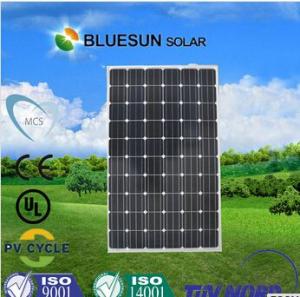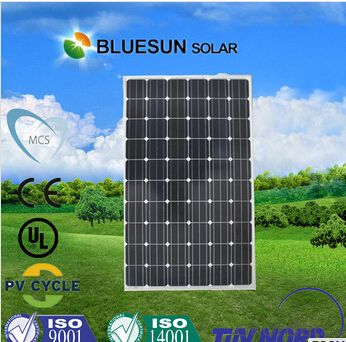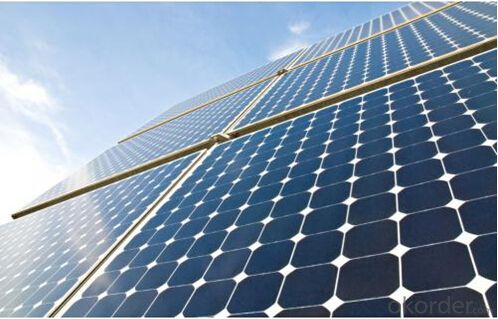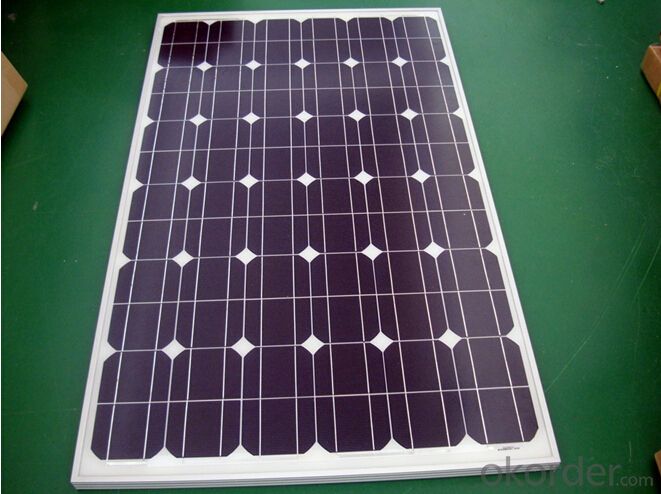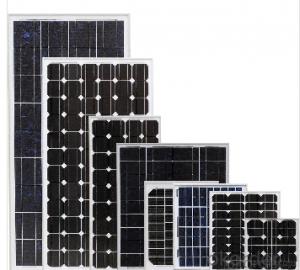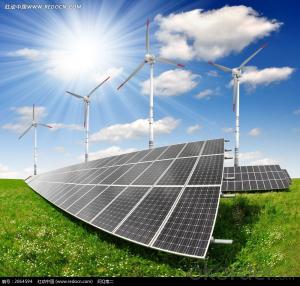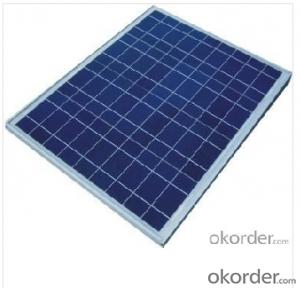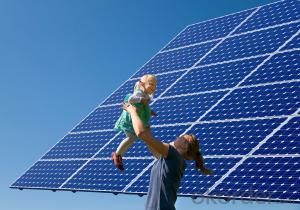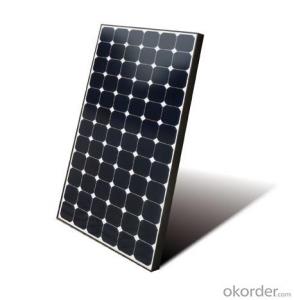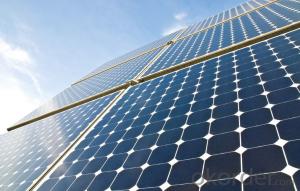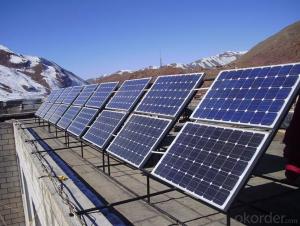Top Ten Solar Panels - Monocrystalline Silicon Solar Modules 245Watt
- Loading Port:
- Shanghai
- Payment Terms:
- TT or LC
- Min Order Qty:
- 24500 watt
- Supply Capability:
- 3000000 watt/month
OKorder Service Pledge
OKorder Financial Service
You Might Also Like
Mono-Crystalline solar panel, Mono 156 cell, 60pcs.Power 245W
1. Structure of Monocrystalline Silicon Solar Modules 245Watt Description
Quality and Safety
1. Rigorous quality control meets the highest international standards.
2. High-transmissivity low-iron tempered glass, strong aluminium frame.
3. Using UV-resistant silicon.
4. IS09001/14001/CE/TUV/UL
Features
1. Aesthetic appearance with excellent efficiency based on innovative photovoltaic technologies.
2. Strong frame, passing mechanical load test of 5400Pa, instead of the normal.
Warranties
1. 10 years limited product warranty
2. 15 years at 90% of the minimal rated power output
3. 25 years at 80% of the minimal rated power output
2. Monocrystalline Silicon Solar Modules 245Watt Specification
ITEM NO.: | Mono 156*156 cell, 60pcs. Power 245Wp | ||||||
Maximum Power(W) | 245 | ||||||
Optimum Power Voltage(Vmp) | 30.1 | ||||||
Optimum Operatige Current(Imp) | 8.21 | ||||||
Open Circuit Voltage(Voc) | 37.4 | ||||||
Short Circuit Current(Isc) | 8.59 | ||||||
Solar Cell: | 156*156 Mono | ||||||
Number of Cell(pcs) | 6*10 | ||||||
Brand Name of Solar Cells | Bluesun Cell | ||||||
Size of Module(mm) | 1650*992*40/45/50 | ||||||
Caple & Connector Type | Pass the TUV Certificate | ||||||
Frame(Material Corners,etc.) | Aluminium-alloy | ||||||
Back Seet | TPT | ||||||
Cell Efficiency for 260W(%) | 16.6% | ||||||
Weight Per Piece(KG) | 19.5KG | ||||||
FF (%) | 70-76% | ||||||
Junction Box Type | Pass the TUV Certificate | ||||||
Tolerance Wattage(e.g.+/-5%) | 0-3% | ||||||
Front Glass Thikness(mm) | 3.2 | ||||||
Temperature Coefficients of Isc(%) | +0.04 | ||||||
Temperature Coefficients of Voc(%) | -0.38 | ||||||
Temperature Coefficients of Pm(%) | -0.47 | ||||||
Temperature Coefficients of Im(%) | +0.04 | ||||||
Temperature Coefficients of Vm(%) | -0.38 | ||||||
Temperature Range | -40°C to +85°C | ||||||
Surface Maximum Load Capacity | 2400Pa | ||||||
Allowable Hail Load | 23m/s ,7.53g | ||||||
Bypass Diode Rating(A) | 12 | ||||||
Warranty | 100% of 10 years,80% of 25 years. | ||||||
Standard Test Conditions | AM1.5 1000W/ 25 +/-2°C | ||||||
Packing | carton or pallet | ||||||
1*20' | 14 Pallets / 316pcs | ||||||
1*40'STD | 25 Pallets / 700pcs | ||||||
3. Detail picture of Monocrystalline Silicon Solar Modules 245Watt
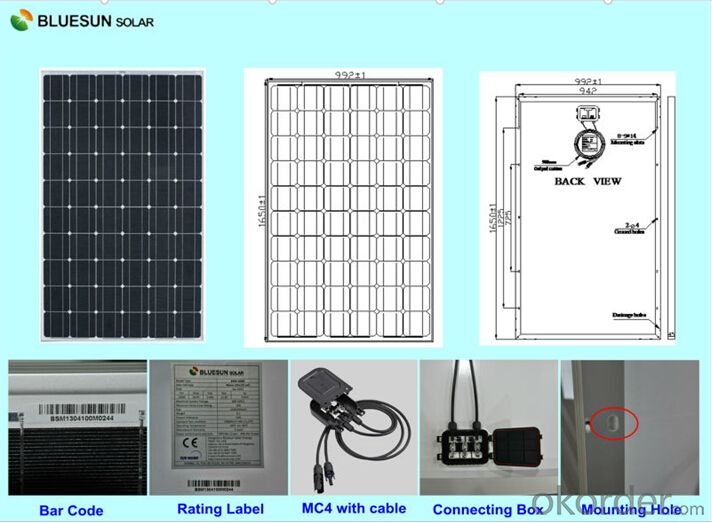
4. Standard production line of Bluesun Factory
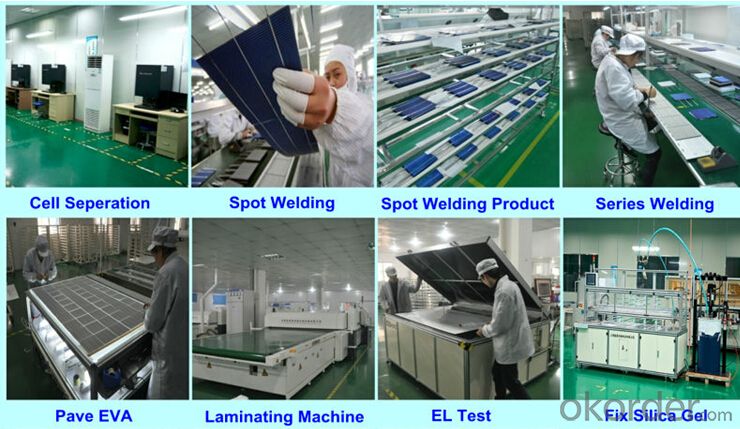

5. Packaging&Shipping of Monocrystalline Silicon Solar Modules 245Watt
Packaging
** Normally packing: 1pc/2pcs/3pcs/10pcs/25pcs per carton
** Individual packing requirement is acceptable.
Shipping
By Sea | Delivery from Shanghai or Ningbo seaport |
| By Air | Departure from Shanghai Pudong Airport |
| By Express | Post by DHL, EMS, UPS, TNT. |
6. Certificate of Monocrystalline Silicon Solar Modules 245Watt
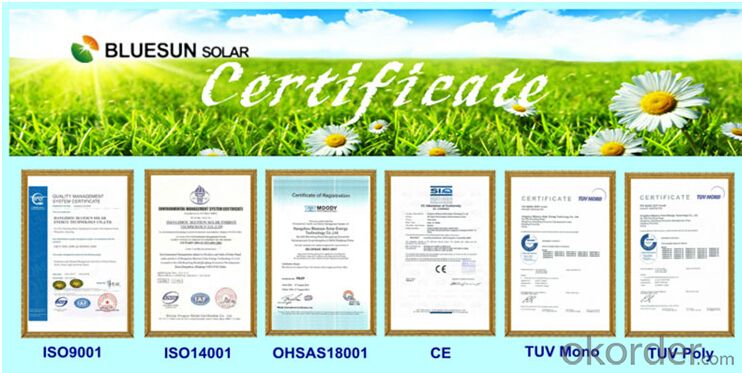
- Q: How do solar panels impact the aesthetics of a building?
- Solar panels can impact the aesthetics of a building in both positive and negative ways. On one hand, when designed and installed properly, solar panels can enhance the overall appearance of a building by giving it a modern and eco-friendly look. Additionally, the sleek and reflective surface of solar panels can add a visually appealing element to the design. On the other hand, some people may find the presence of solar panels on a building to be visually unappealing, especially if they disrupt the architectural harmony or contrast with the surrounding environment. Ultimately, the impact of solar panels on a building's aesthetics is subjective and depends on individual preferences and the integration of the panels into the overall design.
- Q: Can solar panels be used during a power outage?
- No, solar panels cannot be used during a power outage unless they are connected to a battery storage system.
- Q: I am doing a report about solar power and I need to know what determines the amount of electricity produced?example: exposure to sun, angle of panel, qualityplease tell me as much as you canmuch appreciated
- It depends on what you mean by amount of electricity. Normally that would mean the total energy produced over a given period. In that case, the main factors are ) Efficiency of the solar cells 2) Total irradiation received: incident radiation density times the solar panel area, and the angle of the incident radiation. Item ) is determined by the materials and method of construction of the solar cells Item 2) depends on the location of the panel, both on earth's surface (latitude), time of year, and how the panel is oriented with respect to the horizontal. Altitude of the location can also be a factor. Prevailing weather conditions, number of cloudy days, etc. are important. Independent of these parameters, larger area means more electricity.
- Q: when we say a solar panel has 20% efficiency, do we mean that it converts 20% of sunlight reaching it into electricity or that it converts 20% of visible light(which is only 7% of sunlight) into electricity?
- Sunlight power panels had been the go-to choice for many years. They are among the many oldest, most efficient and most liable methods to produce electrical energy from the solar. Every module is made out of a single silicon crystal, and is more efficient, although more pricey, than the more moderen and less expensive polycrystalline and thin-film PV panel technologies. You can normally appreciate them through their color which is more often than not black or iridescent blue. The silicon crystals have lengthy existence and they may be able to withstand wear and tear with out degrading its workability. Additionally solar is a main source renewable vigour as far as the sunlight method is worried. Sunlight has little influence within the residing creature. So sun panel should be in practice
- Q: How long does it take to recoup the cost of solar panels through energy savings?
- The time it takes to recoup the cost of solar panels through energy savings varies depending on factors such as the cost of the panels, the amount of sunlight in the area, the energy consumption of the household, and available government incentives. On average, it can take anywhere between 5 to 20 years to recoup the initial investment. However, with technological advancements and decreasing costs of solar panels, this payback period is steadily decreasing, making solar energy an increasingly attractive and financially viable option for many homeowners.
- Q: All I want to power is a small ice-maker (250 watts) for 25 minutes per day. That's all!!!Can I do that by using a 00 watt panel with 2-3 deep cycle batteries and getting 0 hours of quality light per day.(BTW) what size converter would you recommend? I want more than I need to grow the system
- You okorder /
- Q: What are the supplies needed in a solar panel field, i know there are the panels. But what about batteries, and converters. Possibly other things, and how many will i need, for a certain amount of panels?
- I am interested also and plan on following up on the information in the next couple of weeks
- Q: Are solar panels affected by shade?
- Yes, solar panels are affected by shade. Shade can significantly reduce the efficiency and output of solar panels as shading obstructs sunlight, which is necessary for generating electricity. It is important to install solar panels in areas with minimal shade to maximize their performance and efficiency.
- Q: Are there different types of solar panels?
- Yes, there are different types of solar panels. The most commonly used types include monocrystalline, polycrystalline, and thin-film solar panels. Each type has its own advantages and disadvantages in terms of efficiency, cost, and appearance.
- Q: if you know the area of the panel can u calculate for the wattage or voltage of the panel..
- One square meter of solar panels can produce up to 50 watts of maintenance-free power for up to thirty years. The most common solar panels are for 2 V applications. For sq meter: I = P/V = 50/2 = 2.5 A A single solar cell always produces a voltage of approximately 0.5 volts, regardless of its size. For higher voltages, you have to connect individual cells in series to add their voltages. The larger the solar cell, the greater the current will be. You can also connect cells in parallel to increase current. Hope this helps!
Send your message to us
Top Ten Solar Panels - Monocrystalline Silicon Solar Modules 245Watt
- Loading Port:
- Shanghai
- Payment Terms:
- TT or LC
- Min Order Qty:
- 24500 watt
- Supply Capability:
- 3000000 watt/month
OKorder Service Pledge
OKorder Financial Service
Similar products
Hot products
Hot Searches
Related keywords
